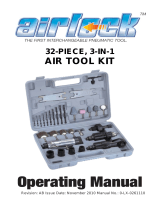
18
fr
Ne pas surestimer ses capacités. Garder une
position et un équilibre adaptés à tout
moment. Cela permet un meilleur contrôle de
l’outil pneumatique dans des situations inat-
tendues.
Porter des vêtements appropriés. Ne pas por-
ter de vêtements amples ou de bijoux. Garder
les cheveux, les vêtements et les gants à dis-
tance des parties en mouvement. Des vête-
ments amples, des bijoux ou les cheveux
longs peuvent être pris dans des parties en
mouvement.
Si des dispositifs sont fournis pour le raccor-
dement d’équipements pour l’extraction et la
récupération des poussières, s’assurer qu’ils
sont connectés et correctement utilisés. L’uti-
lisation de tels dispositifs réduit les dangers
dus aux poussières.
Précautions à prendre lors de l’utilisa-
tion d’outils pneumatiques
Ne pas surcharger l’outil pneumatique. Utiliser
l’outil adapté à votre application. L’outil adapté
réalisera mieux le travail et de manière plus
sûre au régime pour lequel il a été construit.
Ne pas utiliser l’outil pneumatique si l’inter-
rupteur ne permet pas de passer de l’état de
marche à arrêt et vice versa. Tout outil pneu-
matique qui ne peut pas être commandé par
l’interrupteur est dangereux et il faut le répa-
rer.
Interrompre l’alimentation en courant avant
d’effectuer des réglages sur l’outil pneumati-
que, de changer les accessoires ou de ranger
l’outil pneumatique. De telles mesures de
sécurité préventives réduisent le risque de
démarrage accidentel de l’outil.
Conserver les outils pneumatiques à l’arrêt
hors de la portée des enfants. Ne pas permet-
tre à des personnes ne connaissant pas l’outil
pneumatique ou les présentes instructions de
le faire fonctionner. Les outils pneumatiques
sont dangereux entre les mains d’utilisateurs
novices.
Veiller à la maintenance de l’outil pneumati-
que. Vérifier qu’il n’y ait pas de mauvais ali-
gnement ou de blocage des parties mobiles,
des pièces cassées ou toute autre condition
pouvant affecter le fonctionnement de l’outil
pneumatique. En cas de dommages, faire
réparer l’outil pneumatique avant de l’utiliser.
De nombreux accidents sont dus à des outils
pneumatiques mal entretenus.
Garder affûtés et propres les outils permet-
tant de couper. Des outils destinés à couper
correctement entretenus avec des pièces cou-
pantes tranchantes sont moins susceptibles de
bloquer et sont plus facile à contrôler.
Utiliser l’outil pneumatique, les accessoires,
les outils à monter etc. conformément à ces
instructions et aux prescriptions en vigueur
pour ce type d’outil pneumatique. Tenir
compte des conditions de travail et de la
tâche à réaliser. L’utilisation des outils pneu-
matiques à d’autres fins que celles prévues ini-
tialement peut entraîner des situations
dangereuses.
Utiliser les poignées supplémentaires four-
nies avec l’outil pneumatique. Le fait de per-
dre le contrôle de l’outil pneumatique peut
entraîner des blessures.
Maintenir l’outil pneumatique avec les deux
mains et veiller à toujours garder une position
de travail stable. L’outil pneumatique est gui-
dé de manière plus sûre si l’on le tient des
deux mains.
Ne pas travailler de matériaux contenant de
l’amiante. L’amiante est considérée comme
étant cancérigène.
Garder les mains à distance de la lame. Ne
pas passer les mains sous la lame. Le contact
avec la lame peut entraîner des blessures. La
lame de scie peut chauffer énormément
durant le travail.
Ne guider l’outil pneumatique contre la pièce
à travailler que lorsque l’appareil est en mar-
che. Il y a danger de contrecoup ou de perte
de contrôle de l’outil pneumatique.
Il est interdit de visser ou de riveter des pla-
ques ou des repères sur l’outil pneumatique.
Utiliser des autocollants.
Ne pas utiliser des accessoires qui n’ont pas
été spécialement conçus ou autorisés par le
fabricant de l’outil pneumatique. Le seul fait
qu’un accessoire fonctionne avec votre outil
pneumatique ne garantit pas une utilisation
dépourvue de risque.
OBJ_BUCH-0000000116-003.book Page 18 Tuesday, December 6, 2016 11:00 AM




















